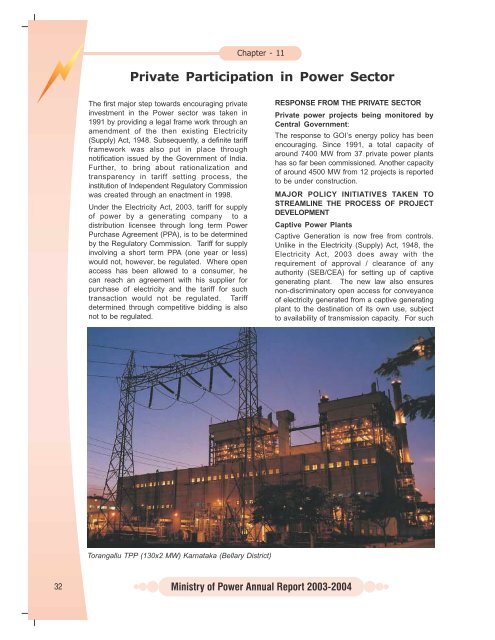Untitled - Ministry of Power
Untitled - Ministry of Power
Untitled - Ministry of Power
You also want an ePaper? Increase the reach of your titles
YUMPU automatically turns print PDFs into web optimized ePapers that Google loves.
32<br />
Private Participation in <strong>Power</strong> Sector<br />
The first major step towards encouraging private<br />
investment in the <strong>Power</strong> sector was taken in<br />
1991 by providing a legal frame work through an<br />
amendment <strong>of</strong> the then existing Electricity<br />
(Supply) Act, 1948. Subsequently, a definite tariff<br />
framework was also put in place through<br />
notification issued by the Government <strong>of</strong> India.<br />
Further, to bring about rationalization and<br />
transparency in tariff setting process, the<br />
institution <strong>of</strong> Independent Regulatory Commission<br />
was created through an enactment in 1998.<br />
Under the Electricity Act, 2003, tariff for supply<br />
<strong>of</strong> power by a generating company to a<br />
distribution licensee through long term <strong>Power</strong><br />
Purchase Agreement (PPA), is to be determined<br />
by the Regulatory Commission. Tariff for supply<br />
involving a short term PPA (one year or less)<br />
would not, however, be regulated. Where open<br />
access has been allowed to a consumer, he<br />
can reach an agreement with his supplier for<br />
purchase <strong>of</strong> electricity and the tariff for such<br />
transaction would not be regulated. Tariff<br />
determined through competitive bidding is also<br />
not to be regulated.<br />
Chapter - 11<br />
Torangallu TPP (130x2 MW) Karnataka (Bellary District)<br />
RESPONSE FROM THE PRIVATE SECTOR<br />
Private power projects being monitored by<br />
Central Government:<br />
The response to GOI’s energy policy has been<br />
encouraging. Since 1991, a total capacity <strong>of</strong><br />
around 7400 MW from 37 private power plants<br />
has so far been commissioned. Another capacity<br />
<strong>of</strong> around 4500 MW from 12 projects is reported<br />
to be under construction.<br />
MAJOR POLICY INITIATIVES TAKEN TO<br />
STREAMLINE THE PROCESS OF PROJECT<br />
DEVELOPMENT<br />
Captive <strong>Power</strong> Plants<br />
Captive Generation is now free from controls.<br />
Unlike in the Electricity (Supply) Act, 1948, the<br />
Electricity Act, 2003 does away with the<br />
requirement <strong>of</strong> approval / clearance <strong>of</strong> any<br />
authority (SEB/CEA) for setting up <strong>of</strong> captive<br />
generating plant. The new law also ensures<br />
non-discriminatory open access for conveyance<br />
<strong>of</strong> electricity generated from a captive generating<br />
plant to the destination <strong>of</strong> its own use, subject<br />
to availability <strong>of</strong> transmission capacity. For such
















